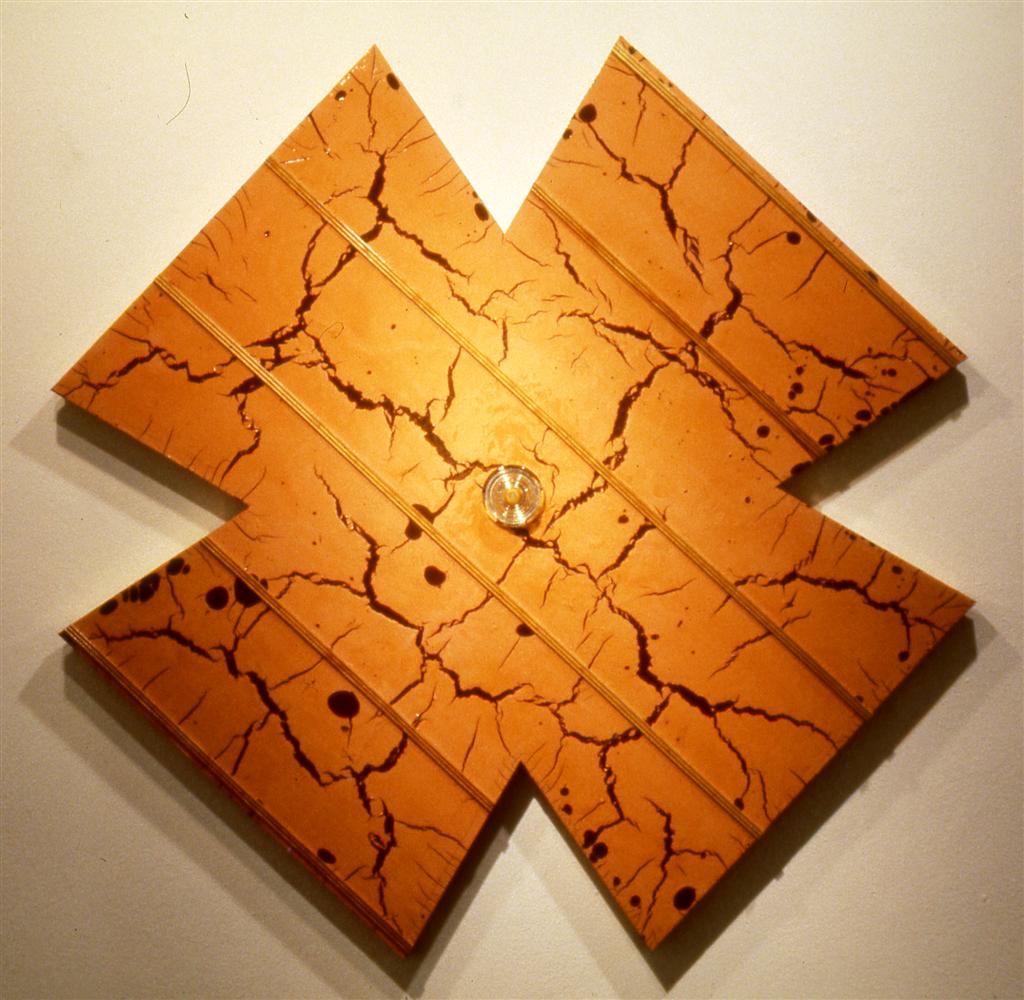500X Gallery, Dallas, Texas
March 9 - 30 1991
Tom Moody Texas Editor of Art Papers
Published: Art Papers May-June 1991
Playing the role of the Mad Inventor, David Szafranski uses the Duchampian machine to probe the squishy realm where sex, politics, and religion conjugate. The attack on the status quo takes place on two fronts---social and aesthetic. The former is concerned with questions such as "How valid is a religion that worships death and denies life?" The latter is an even more vexing question: "Can an inflatable hemorrhoid cushion be perceived as a thing of beauty?"
 In a wall sculpture
called Reliquary,
Szafranski pulls a switch on the ancient, ghoulish
practice of enshrining the bones of saints. A nipple from
a baby bottle lies sealed beneath the glass top of a
quotidian candy jar, in the center of a heavily-lacquered
vertical tabletop cut in the shape of an Iron Cross. Which
is more wholesome to contemplate, the piece seems to ask:
the nipple, with its associations of procreation and
nurturing, or the dried up remains of a long-dead martyr?
In a wall sculpture
called Reliquary,
Szafranski pulls a switch on the ancient, ghoulish
practice of enshrining the bones of saints. A nipple from
a baby bottle lies sealed beneath the glass top of a
quotidian candy jar, in the center of a heavily-lacquered
vertical tabletop cut in the shape of an Iron Cross. Which
is more wholesome to contemplate, the piece seems to ask:
the nipple, with its associations of procreation and
nurturing, or the dried up remains of a long-dead martyr?Perhaps the nipple isn't so wholesome, since arguably bottle-feeding is to nursing what artificial insemination is to the act of love. The medieval reliquary at least contained a palpably human—albeit fragmentary—object and not a plastic surrogate. Maybe, as religious commodities go, a life-fetish is an improvement over a death-fetish; somehow Szafranski make the whole issue seem fraught with complications.
The hemorrhoid cushion makes its appearance in Variable Speed Emergency Illumination Device, one of Szafranski's most elegant works. A lamp base, painted brick red, supports an electric motor that turns the cushion—an orange bladder resembling a life preserver, bearing the B.F. Goodrich logo. As the cushion spins, a series of auto safety flares attached to it with chains whirl about centrifugally; if the flares are ignited, the lamp provides about fifteen minutes of emergency illumination and laughs. To answer the question above, yes, the cushion is quite beautiful, when seen in the context of a carefully constructed object with a weirdly harmonious color scheme.
The Cause of Movers and Shakers literally jerks us into the world of politics. A wall-mounted motor from an exercise belt bobs up and down with a masturbatory rhythm, giving a provocative shake to a cylindrical curtain of beads and bamboo. The curtain recalls the bordellos where movers and shakers (in Texas, at least) go to unwind, and the circular fluorescent bulb at the top of the curtain evokes the halo of sanctimony they assume when caught with their pants down.
The Cause of Knockers (my favorite title in the show) is a companion piece to Reliquary and employs a similar inversion. The vertical tabletop, this time circular, is coated with immiscible layers of oil and acrylic paint that pool and crack as they dry to yield a rich, ridiculous surface with the look of fake Naugahyde. In the middle of the disc sits a brass doorknocker replete with security peephole. A glimpse through the hole provides a fish-eye view of a postage-stamp sized religious tract: "Personal Bible," it reads, in Gothic letters, "Verses of Comfort/Assurance/Salvation." Thus salvation, rather than sin, becomes the main attraction in a pornographic peep show—or looked at another way, the viewer has traded positions with the missionary on the doorstep.
One of the least political of Szafranski's pieces is also the most sublime. Vogue Oil-Glo Device is a suspended cage of electrical conduit that brings classical perfection to post-industrial ornament. Where lengths of conduit intersect, electrical outlets hold plug-in devices producing light or sound. The lights are tapering clear bulbs with saw toothed filaments flickering orange; the noisemakers are rounded buzzers that give off annoying blasts on a two-second pulse. The materials couldn't be more graceful. In a town where good sculptors can be numbered on the fingers of one hand with several fingers amputated, Szafranski is the opposable thumb.
---
Tom Moody, a Dallas artist, is Texas
editor of Art Papers, an art journal based in Atlanta.